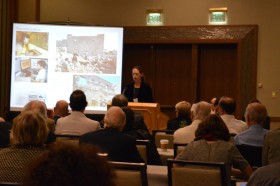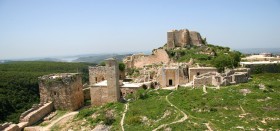7 Things You Should Know About ASOR’s Syrian Heritage Initiative
Beginning August 4, the American Schools of Oriental Research entered into a cooperative agreement with the U.S. Department of State to monitor, document, and report on cultural heritage damage in Syria.
Archaeology in Lebanon Today: Its Politics and Its Problems
By: Hélène Sader Lebanon has a long and very rich past, but in spite of the country’s wealth of ancient settlements, compared to neighboring countries archaeological research is far behind. While in the last decades archaeological research has greatly enhanced our understanding of Syria’s, Jordan’s, and Palestine’s past, Lebanon appears to be lagging behind and […]
Legacy Excavations and Linked Open Data: A Virtual Vision of Sir Leonard Woolley’s Ur
By: W.B. Hafford, University of Pennsylvania Digital data plays an ever increasing role in archaeology. Archaeologists use computers for virtually every task, from artifact recording to site mapping, and the amount of data we gather is staggering. This is a good thing, but proper management and archiving of the data can overwhelm a dig crew. […]
The Virtual World Project: Touring The Ancient World
By: Ronald A. Simkins and Nicolae Roddy, Creighton University There is nothing quite like teaching at an archaeological site, where ancient remains almost speak out to students as witnesses of the past. Both authors have led study tours in Israel, taking students to archaeological sites like Tel Dan, Bethsaida, Megiddo, Arad, Beer-sheba, and others, lecturing […]
iPads in the Field and Reflections on Archaeology’s Digital Future
By: William Caraher, University of North Dakota This past summer my excavation on Cyprus experimented with using iPads to document our excavations in the field. Since, I have co-directed the Pyla-Koutsopetria Archaeological Project with Prof. R. Scott Moore of Indiana University of Pennsylvania and Prof. David K. Pettegrew of Messiah College. Over this time, […]
Sustainability at Any Price is not Sustainable: Open Access and Archaeology
By: Eric Kansa, UC Berkeley and This blog post looks at the open access debate, and notes how sustainability is as much of an ideological and political question as it is a financial issue. It is intended to follow up on previous blog posts (first, second, third) that discuss how the Aaron Swartz prosecution […]
Archaeology and Cultural Heritage in Egypt after Mubarak
By: Greg Williams Egypt’s January 25th revolution was originally seen as part of the larger “Arab Spring” across the Middle East where old political regimes were overthrown by popular protests and replaced by representative democracies. But on January 28th, as chaos reigned in Cairo’s Tahrir Square, reports began circulating around the globe claiming that […]
Using Inscriptions from the Antiquities Market: Polarized Positions and Pragmatic Proposals
By: Christopher A. Rollston Archaeological sites in the Middle East have been ransacked, pillaged, and plundered for many decades. The motivations of the actual pillaging are normally economic: the pursuit of marketable artifacts. That is, the pillagers wish to find objects that can be sold to collectors. Of course, the motivations of the collectors who […]
The Dilemma of Denial: Scholarly Publication Policies and the Illusion of Power
By: Jonathan Rosenbaum President Emeritus, Gratz College For generations, academic journals have been deemed the appropriate venue for the initial publication of ancient inscriptions and artifacts. Nevertheless, last fall, the New York Times became the source of an editio princeps when it announced the discovery of a “faded papyrus fragment” that seemed to be “first […]
The Cultural Afterlife of Mosaics in Turkey
By: Laurent Dissard, University of Pennsylvania Sensational discoveries of mosaics periodically make the headlines of newspapers in Turkey. After being discovered, unearthed, cleaned, and removed, these ancient floors slowly make their way to museums or private collections. For this month’s ASOR Blog on the Archaeology of Anatolia, I wish to examine the curious afterlife of mosaics […]
The Terms of Heritage
By: Kathryn McDonnell Specialized terminology, such as stake holders, the “universal museum,” provenance, or even the phrases, “cultural property” or “cultural heritage,” is often used during discussions between law enforcement professionals, such as Homeland Security Investigations (HSI) in the US or the Carabinieri in Italy, diplomats (ICOMOS), lawyers, and scholars, including archaeologists. Although these terms […]
Contested Heritage and the New Museum(s) in Diyarbakır
By: Laurent Dissard The southeastern provinces of Turkey will soon be home to a series of new, state-of-the-art, archaeology museums. Such buildings are being (or have already been) planned, constructed, remodeled, or expanded. The Gaziantep Museum, for instance, houses many of the Roman mosaics of Zeugma unearthed before the construction of the Birecik Dam. Other […]
Archaeological Conservation Strategies in the Near East, Fri. Nov. 16
By: Suzanne Davis and LeeAnn Barnes Gordon This year we are pleased to announce a new workshop session for the ASOR Annual Meeting, Archaeological Conservation Strategies in the Near East. Both conservators and archaeologists tend to present research within their own fields, effectively segregating the disciplines. But this year, thanks to ASOR, we have an […]
A builders’ heritage at Umm el-Jimal
EnglishEnglishFrenchPowered by TranslateBy: Bert de Vries (Calvin College) and Muaffaq Hazza (Umm el-Jimal) Inthe Umm el-Jimal (UJ) Project received a grant from the U.S. Ambassadors Fund for Cultural Preservation (AFCP) to engage in preservation and presentation of House XVII/XVIII, the very large Byzantine/Umayyad House famous for its fourth-floor level double windows (Photo 1). The […]
From Destruction to Archaeology: the significance of “Operation Anchor” for the Cultural Heritage of Jaffa.
By: Martin Peilstöcker During spring 1936 the nationalistic uprising of the Palestinian Arab population against Mandatory British rule and Jewish mass immigration became more and more violent. A strike was declared on Jaffa port, in those days still one of most important harbors of Palestine. Groups of Palestinians left the narrow alleys of the Old […]
Protecting, Preserving, and Presenting Cultural Heritage in Petra: The Temple of the Winged Lions Cultural Resource Management Initiative
By: Christopher A. Tuttle Two hundred years ago, on 22 August 1812, the ancient city of Petra was re-identified by the Swiss explorer Johann Ludwig Burckhardt, the first European on record to have visited the site since the 13thcentury. Word of his discovery quickly spread and other visitors soon followed in his footsteps—inaugurating a bicentennial of […]
Protecting Archaeological Sites in Conflict Zones: What Is to be Done in Syria?
By: Lawrence Rothfield The recent upsurge in high profile news stories, in Time and other mass media outlets, about the looting of archaeological sites in Syria has been accompanied by the usual public handwringing by archaeologists and heritage protection organizations. The terrible impact on the world’s cultural patrimony is bewailed, and the heads of UNESCO, […]




